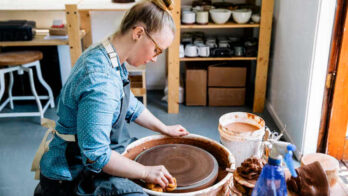Whether you’re seasoned potter in the market for a new pottery wheel or a complete novice looking for the best pottery wheels for beginners, you’ll want to ensure you get one that suits your needs. One of the biggest decisions you’ll make is choosing a pottery kick wheel vs. electric pottery wheel, and just like any other product, there are advantages and disadvantages to both.
Regardless of which type of pottery wheel you choose, you should consider it an investment because they can be pricey, even at the lower end of the scale.
Nevertheless, when you’re trying to decide on the perfect pottery wheel, here are some things to take into consideration:
Your Budget
Pottery wheels can cost as little as $400 or as much as $2000+. As a general rule, electric pottery wheels can be more expensive than the regular kick wheels, but the price is affected by much more than this.
The price of a pottery wheel is based on its features and special capabilities, so it’s possible to find both of these types of wheels at roughly the same price.
Having said this, keep in mind that the lower-priced pottery wheels are usually less durable, have a lower speed and overall power, allow you a lower clay weight limit, and are usually very basic in both design and function.
When shopping for the right pottery wheel, it’s important to compare all of the features so that you can compare apples to apples in the end.
You might also want to take a basic pottery class if this is your first time buying a wheel. This way, you can get a better idea if this hobby is one you’ll want to stick with, which affects how you feel about spending a lot of money on your pottery wheel.
The Portability of Your Wheel
Not all pottery enthusiasts will be transporting their pottery wheel from one location to another. Still, if you regularly conduct classes or like to take your wheel outside, you have to consider the portability of that wheel.
And there’s a big difference between kick wheels and electric wheels in this respect. Kick wheels have no motor and are operated manually via a pedal that you operate with your foot. On the other hand, electric pottery wheels need a cord and an outlet of some type.
When it comes to portability, electric pottery wheels are usually your smartest option. While they do need electricity to run, which isn’t always available when you’re outdoors, you can still easily bring them anywhere you need to go.
Also, electric wheels are usually around 35 pounds, while a kick wheel is often around 250 pounds. Electric pottery wheels are always more lightweight than kick wheels, which is important if you’re planning to take them to various locations.
The Noise Level & Speed of Your Pottery Wheel
All pottery wheels make noise, but as a general rule, kick wheels are generally much quieter than electric wheels are. If you buy an electric pottery wheel, you can expect to hear squeals, rumbling, humming, and even grinding noises, especially during throwing.
This is especially true if you’ve purchased a cheaper model. It’s nothing to be alarmed at because it is normal, but if your goal is to own a super quiet pottery wheel, you’ll want to go ahead and choose the standard kick wheel model.
Regarding the speed of your pottery wheel, keep in mind that electric wheels allow you to throw faster, which is a time-saver when doing your production work. Kick wheel models result in a slower throwing process, but some also come with motors that can help you increase your speed.
In addition, if you’re an inexperienced potter, be careful with the electric wheels because you might increase the speed too quickly, which can affect your throwing ability in a negative way.
The Physical Demands of the Wheel
Suppose you have knee problems or other physical limitations. In that case, you might want to consider an electric pottery wheel because, as a general rule, they require very little physical effort to work properly.
This is because electric pottery wheels have motors, while kick wheels do not. Therefore, with an electric wheel, you can take advantage of the wheel’s momentum and use very little of your own physical effort.
In short, it’s much easier on your entire body when you use an electric pottery wheel when compared to a kick wheel. And as far as the throwing process is concerned, you can usually center your clay a lot easier when you have a pottery wheel with a motor, i.e., an electric pottery wheel.
Since most electric wheels have pedals that you can rotate clockwise and counterclockwise, right-handed and left-handed throwing are accommodated.
Kick wheel models still accommodate left-handed and right-handed throwing, just the same as the electric ones. In many ways, kick wheels give the artist better overall control of the throwing process, which is why some people choose this type.
The Maintenance & Maneuverability of the Pottery Wheel
When it comes to your pottery wheel’s overall maintenance, it should be no surprise that kick wheels are easier to maintain. This is partly because electric pottery wheels tend to have more components and parts, and you must keep an eye on those parts to ensure none break or need to be replaced.
A kick wheel usually consists of a frame made of either wood or steel and is controlled by the potter’s foot. There is simply less to worry about with kick wheels because of how they are designed.
Regarding maneuvering your pottery wheel, keep in mind that electric wheels are lighter and therefore easier to maneuver. If you’re cleaning your wheel, for instance, its weight will determine how complex the cleaning job is. Moving the pottery wheel around as you clean it is simply a lot easier with an electric wheel since it is lighter in weight and usually smaller in size.
Find out how to use a pottery kick wheel by watching this great tutorial from Robert Banker.
The Bottom Line
So, which pottery wheel is right for you — electric or kick wheel? That depends on you, of course, because some of the features of each type of wheel are more important than others to the buyer.
One important aspect to remember is how long you plan to use your pottery wheel. If it’s something you already know you’re going to continue working with, you might as well go for the best pottery wheel out there, even if it’s more expensive.
That being said, pottery wheels differ in weight, throwing ability, overall size, and many other features, so you’ll have to consider all of these things before you make your final decision.
Conclusion
Both kick wheels and electric pottery wheels offer advantages and disadvantages. Some people make the mistake of choosing their pottery wheel only on price and nothing else, but that is always a mistake.
Some cheaper models simply do not last and don’t offer the perks that more expensive models do, so when you’re deciding on a good pottery wheel, you should take all of these things into consideration.
Featured image courtesy of Joel Cherrico Pottery



Enter your email below to get our FREE beginner friendly tips.
By entering your email address you agree to receive emails from Potters Passion. We'll respect your privacy and you can unsubscribe at any time.



